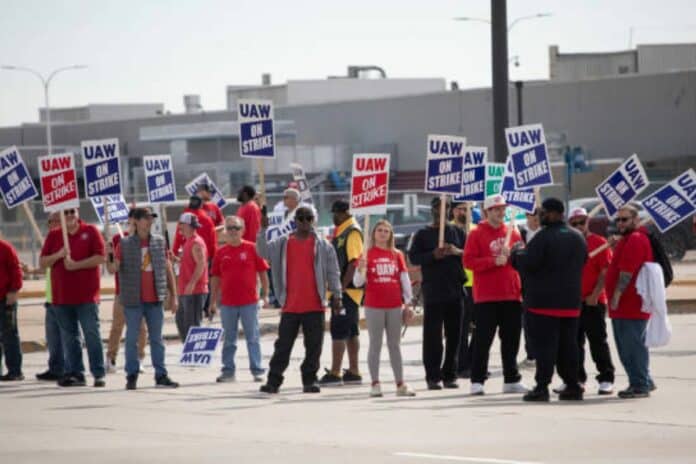Detroit’s automotive giants, known as the Big Three, are grappling with the fallout of the United Auto Workers (UAW) strike, which is now in its fourth week. Approximately 5,000 autoworkers have been laid off due to the labor dispute.
Layoffs Across the Big Three
On Monday, General Motors (GM) confirmed the idling of 155 workers at plants located in Indiana, Michigan, and Ohio. Ford, on the other hand, had to let go of 537 workers in Michigan and Ohio. Furthermore, Stellantis, the parent company of well-known brands such as Chrysler, Dodge, Jeep, and Ram, recently laid off 570 workers in Indiana and Michigan as of October 6. Ford, GM, and Stellantis have, in total, released 4,835 non-union workers due to strike-related issues. Ford alone has laid off 1,865 employees, GM 2,330, and Stellantis 640.
Automakers contend that these layoffs were an unfortunate necessity since the affected workers’ job tasks were closely linked to the factories called upon to strike by the UAW. However, the automakers have not disclosed their intentions to rehire these workers once the strike concludes.
Bryce Currie, Ford’s Vice President for Americas Manufacturing and Labor Affairs, stated, “While we are doing what we can to avoid layoffs, we have no choice but to reduce production of parts that would be destined for a plant that is on strike. Strike-related layoffs are an unfortunate result of the UAW’s strategy.”
The UAW’s Stand-Up Strike
The UAW initiated a “stand-up strike” last month, with nearly 13,000 autoworkers halting work at Big Three assembly plants in Michigan, Missouri, and Ohio. The UAW’s demands include a 36% pay increase over four years, annual cost-of-living adjustments, pension benefits for all employees, greater job security, a faster path to full-time status for temporary workers, and a four-day work week. In response, automakers have resorted to laying off thousands of non-union workers.
It is worth noting that these layoffs are distinct from the hundreds of workers released by companies that supply parts to Ford, GM, and Stellantis. For example, LM Manufacturing, a Michigan-based company producing seats for the Ford Bronco, temporarily laid off approximately 650 workers last month due to the UAW strike. Similarly, Sodecia Automotive announced last week that it would temporarily lay off around 140 workers until late November.
GM’s Agreement in Canada
The strike’s impact extended beyond the U.S. borders, as GM workers in Ontario, Canada, also walked off the job. Subsequently, an agreement was reached, with GM announcing the resumption of work at its facilities in Canada.
Old Article: Walt Disney Devastates Employees with Second Layoff announcement – Thousand of Jobs Cut
Lana Payne, President of the Unifor Union, which represents more than 20,000 Canadian autoworkers at the Big Three, stated that GM agreed to crucial demands, including pensions, retiree income, and converting temporary workers into permanent employees. This new agreement applies to approximately 4,300 autoworkers at three GM facilities in Ontario.
Back in Michigan, UAW President Shawn Fain reported that talks between the union and the Big Three were progressing in a positive direction. GM’s decision to include employees at its forthcoming electric vehicle battery plant in Indiana within the UAW contract marked a significant development.
Ongoing Negotiations and Economic Impact
Negotiations between the UAW and the automakers are ongoing, with both sides presenting counteroffers. GM recently offered a 20% wage increase, an 8% company contribution to employee retirement accounts, and an increase in temporary worker wages to $20 per hour. However, an end to the strike remains uncertain.
The longer the UAW strike continues, the more it adversely affects the nation’s economy. According to Anderson Economic Group, a Michigan consultancy firm, the three weeks of the strike have cost the U.S. economy approximately $5.5 billion. This figure includes losses of around $2.68 billion for the Big Three and $1.6 billion in losses for parts suppliers.

